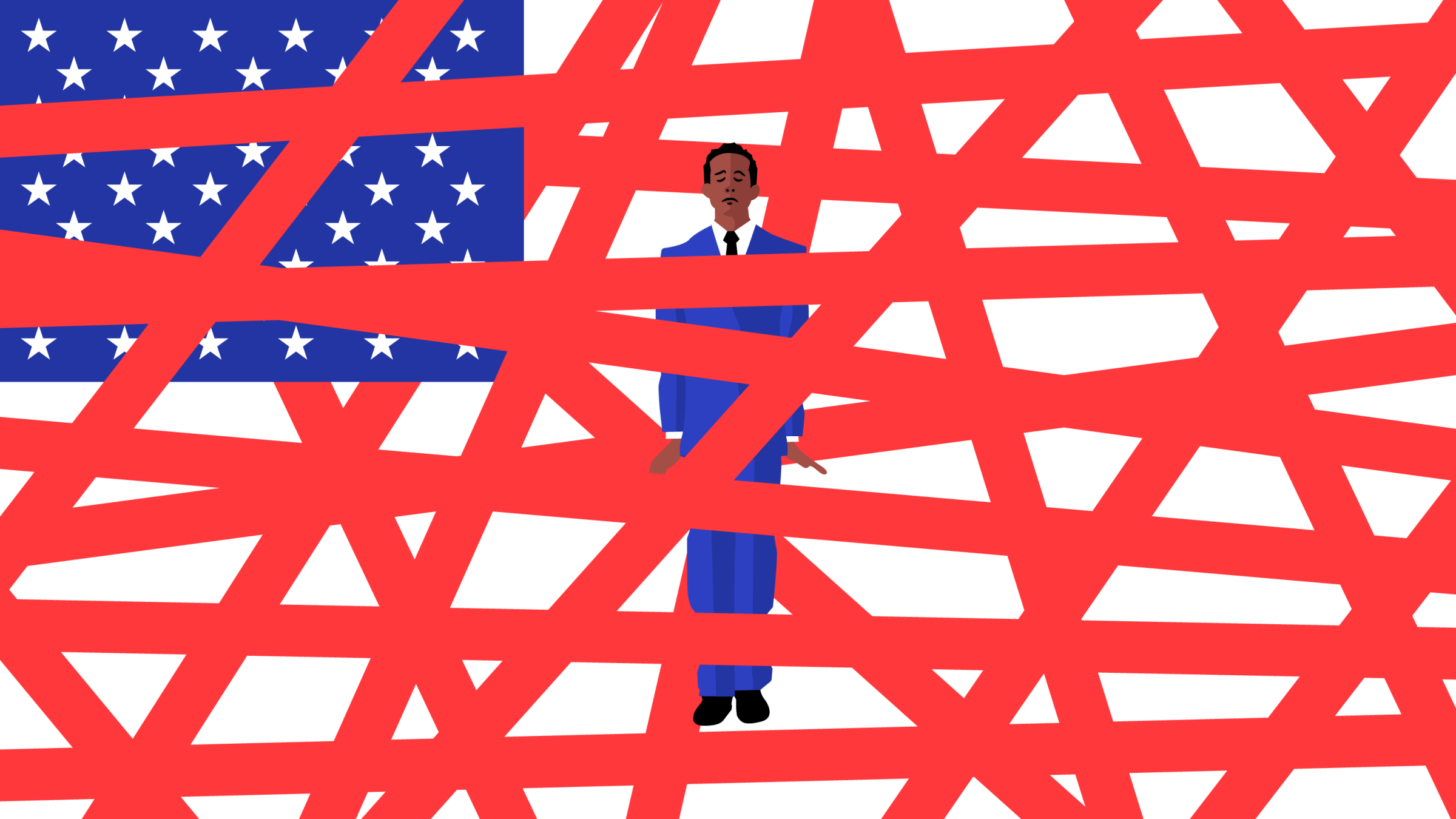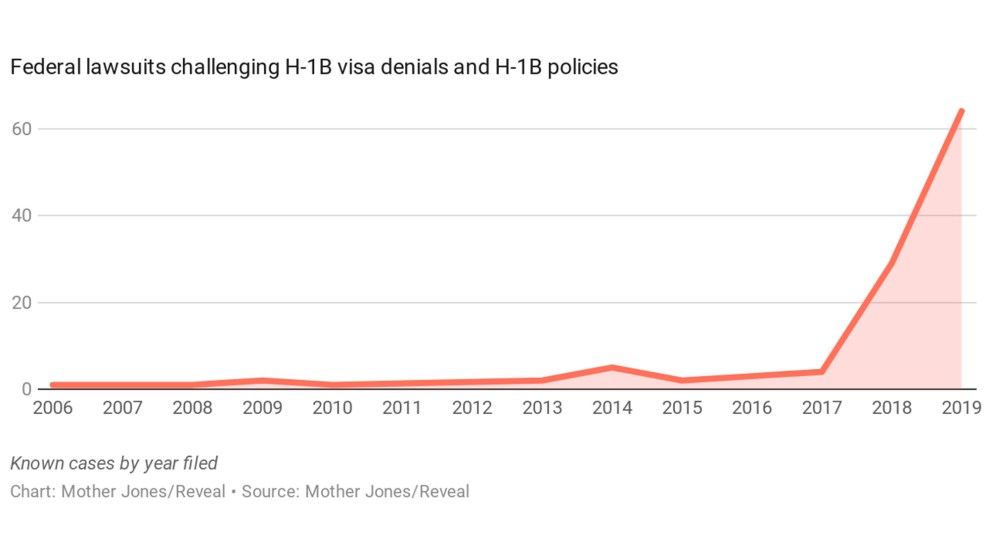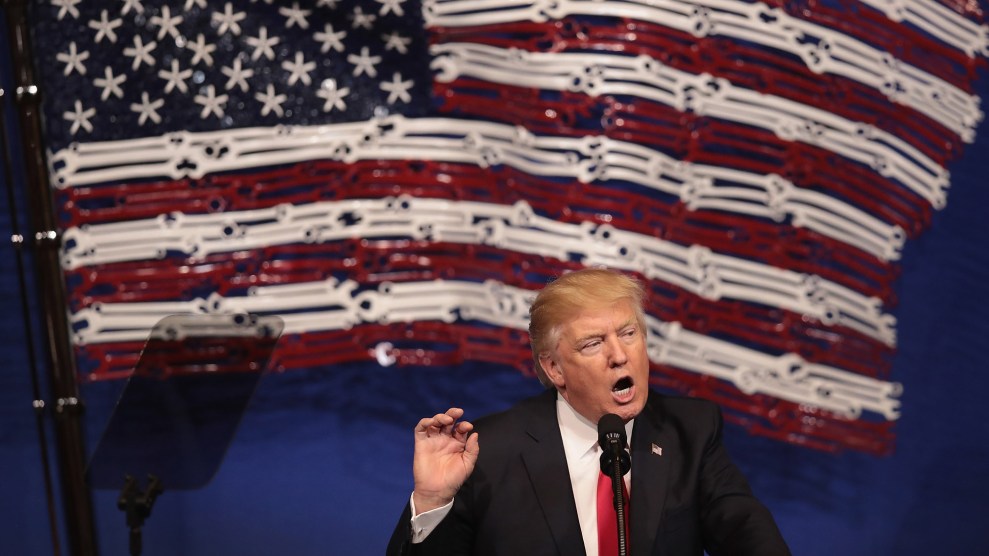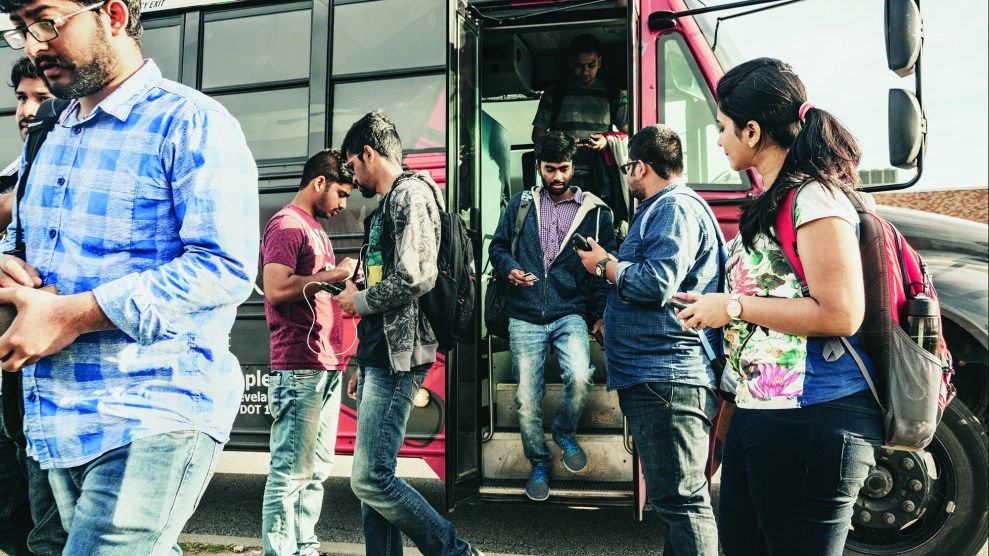This investigation is a collaboration between Mother Jones and Reveal. Listen to the latest episode of Reveal below for more on this story and to learn more about how Sinduja Rangarajan reported it.
Samir came to the United States from India in 2006 as a graduate student. He got a master’s degree in environmental engineering, and after a few internships where he picked up programming skills, he was hired in 2010 by UnitedHealthcare, a Fortune 500 insurance company based in Minnesota. He loved his job streamlining its claims process. “There were days where I worked three days nonstop, no sleep, nothing, because we wanted people to get cured—they need to get the treatment,” he recalls. “I put my soul in there.”
The insurance company got him an H-1B, a temporary work visa reserved for high-skilled foreigners who can fill jobs for which there’s a shortage of American workers. His visa was regularly renewed, and after a few years, his employer sponsored him for a green card and his application was approved. Samir thought he would spend the rest of his life in his adopted country. “I never used to celebrate Christmas back home in India,” he says. “But I did go to church here for the first time, just to see how they celebrate. This country is built on immigrants, right? I wanted to feel that.”
In early 2018, Samir was transferred to a subsidiary of UnitedHealth Group in Dallas. It was a lateral move, but it required him to get his H-1B transferred. A few months later, he learned that US Citizenship and Immigration Services (USCIS), the agency that approves visas, had rejected what should have been a routine approval. Overlooking his eight years of experience, the agency said his education didn’t line up with his position and determined that he wasn’t qualified to do it anymore. When his visa was denied, Samir says he lost his job.
Suddenly, the life that Samir had painstakingly built came crashing down. He and his wife had to explain to their 5-year-old son that they’d have to move out of their dream house in suburban Dallas—the one they’d built with most of their savings. They sold it in a rush and moved into a tiny apartment. Samir had a few weeks to find another employer who’d sponsor his H-1B or he’d have to leave the country. After 12 years in the United States, he was suddenly faced with the idea that America was no longer home.
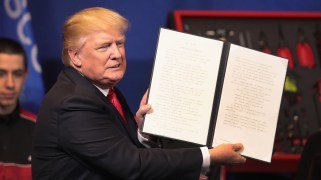
President Trump signed an order to overhaul the H-1B visa program in April 2017.
Scott Olson/Getty Images
Samir, who asked not to use his real name because he fears his future visas may be denied, is one of thousands of H-1B holders who have found that the Trump administration has upended the once-predictable rules for who gets (and keeps) these coveted visas, which are a major source of high-skilled immigrants, particularly from India. Even as President Donald Trump has complained about rules that prevent American companies “from retaining highly skilled and… totally brilliant people” from abroad, his administration has made sweeping changes to the H-1B program, denying visas to skilled immigrants, some who have been working in the United States for years. USCIS has been denying H-1B petitions at a record rate: 24 percent of first-time H-1B applications were denied through the third quarter of 2019 fiscal year, compared with 6 percent in 2015. In the 2015 fiscal year, only 3 percent of H-1B transfers and extensions like Samir’s were denied. In 2019, 12 percent were. In total, about 50,000 people were denied H-1B visas in the past year.
Trump is denying H-1Bs at a record rate
The administration says it’s tightening H-1B policies to prevent fraud and award visas only to the “most-skilled or highest-paid beneficiaries.” Yet an investigation by Mother Jones and Reveal has found that the administration has been denying visas to experienced, well-paid workers, many of whom have degrees from American universities and have previously received H-1Bs. Our analysis shows that a record number of H-1B–related federal lawsuits have been filed against USCIS in the past two years. The complaints allege that the agency has been making inconsistent and incorrect decisions, ignoring evidence, and misapplying the law.
Sandra Feist, an immigration attorney in Minneapolis, says navigating the new bureaucratic obstacles for visa holders has been more stressful than any other period in her career. “I was working in the field after 9/11, and this is infinitely worse,” she says. “And the clients that I work with have been treated with much more skepticism and cynicism than even in that era.”
Immigration-law experts see the administration’s restrictions on these specialized visas as part of the larger anti-immigration agenda pushed by hardliners like acting USCIS Director Kenneth Cuccinelli and White House senior policy adviser Stephen Miller. “Attacking legal immigration is kind of a stealth strategy,” says Bruce Morrison, a former Congress member from Connecticut who co-sponsored the Immigration Act of 1990, which established the H-1B program. “People who are just listening to the news are easily seduced into thinking this is all about protecting the border or protecting our security or making sure the people who are here are here legally. But in fact, this is a wholesale isolationist administration. It doesn’t like anything that isn’t stamped ‘Made in America,’ whether it’s the individuals, or whether it’s the products.”
The H-1B program annually issues around 85,000 new visas to recipients from around the globe, with the majority going to people from India and China. Though Silicon Valley relies heavily on these “tech visas,” they’re also used by universities, hospitals, and pharmaceutical companies. Visas are usually issued for three years, followed by three-year extensions. If the visa holder’s employer files for a green card, they may get unlimited H-1B extensions until their residency is approved. In the past, the process for renewing H-1B visas was relatively predictable, particularly if there were no major changes to the visa holder’s job.
Pro-labor groups, anti-immigration think tanks, and conservative politicians have called for the program to be reformed. Critics argue that a disproportionate number of H-1B visas go to IT consulting companies that replace American workers with underpaid foreign workers. (Both Mother Jones and Reveal have reported on the “body shops” that take advantage of tech workers eager to work in the United States.)
Key figures in the Trump administration have criticized the H-1B system. In late 2015, Sen. Jeff Sessions (R-Ala.), the future attorney general, described the program as “a tremendous threat” to American workers on Sirius XM’s Breitbart News Daily podcast. In 2016, Sessions chaired an immigration subcommittee hearing where witnesses urged Congress and the Obama administration to reform the program, citing examples of large companies that had laid off American workers and substituted them with H1-B holders. Speaking with Steve Bannon on the Breitbart podcast in March 2016, Stephen Miller, the Sessions aide who would become the architect of Trump’s immigration policy, said H-1B recipients were not necessarily high-skilled workers. “The reality is we’re talking about less skilled foreign guest workers that are less educated than Americans, who are paid less than Americans, who know less about the computing industry and about the technology industry than Americans.”
As a recent investigation by Highline details, the new administration quickly got to work on implementing bureaucratic restrictions on all kinds of immigration—an “invisible wall.” In April 2017, President Trump announced his Buy American Hire American executive order in a speech at a tool company in Wisconsin. “Widespread abuse in our immigration system is allowing American workers of all backgrounds to be replaced by workers brought in from other countries to fill the same job for sometimes less pay. This will stop,” he declared. The H-1B program needed “long-overdue reform,” he said. “They should be given to the most-skilled and highest-paid applicants, and they should never, ever be used to replace Americans.”
When Trump signed the executive order, Stephen Yale-Loehr, an immigration law professor at Cornell University, thought the administration would implement its proposed changes through the usual rulemaking process. “I guess I was naive, because instead of doing that, they simply reinterpreted the existing regulations more narrowly,” he says. “Normally I’d ask for more scrutiny of H-1B visas,” says Daniel Costa, director of immigration law and policy at the Economic Policy Institute, a pro-labor think tank. “But this administration, with its anti-immigration bent of mind, is probably not the best one to do it.”
Since early 2017, a series of USCIS memos have outlined dramatic changes to how the H-1B program is administered. A memo published a few days before Trump’s executive order instructed reviewers to examine whether H-1B applicants held jobs that required a college degree and put stringent requirements on which degrees qualify for H-1Bs. An October 2017 memo required every H-1B case to be evaluated without giving any weight, or “deference,” to past approvals. Previously, USCIS officers would not deny an H-1B renewal if the visa had been approved in the past and there was no reason to scrutinize the application. A memo in February 2018 targeted IT staffing companies, some of the heaviest users of the H-1B program.
The new rules have shaken up the once-predictable H-1B application process. According to USCIS data, the denial rates for H-1B visas in the 2018 and 2019 fiscal years were the highest of the past decade. One of the largest IT hiring firms, Tata Consultancy Services, has had more than a third of its new visa petitions rejected in 2019, compared with 6 percent four years earlier. In 2015, the consulting firm Ernst and Young applied for almost 700 new H-1B visas and received two denials. In 2019, it applied for 40 percent fewer visas and received 75 denials. IBM applied for 213 new visas in 2015 and two were denied. In 2019, it applied for around 1,100 and over a third were denied.
Companies see “tech visa” denials spike
Lawyers and immigration experts say the new rules are vague and are being applied unpredictably. “The administration is intentionally giving [USCIS officers] much more leeway on how to decide cases, and they are also removing some of the guardrails that prior administrations sought to get consistency in how things were decided,” says Lynden Melmed, an immigration attorney and the former chief counsel of USCIS in the Bush administration. “It’s very difficult for individuals and families to go through an immigration process where they don’t know what the rules are, or the rules will change midstream on them.”
“We’re seeing very, very strange and unreasonable and illogical denials,” says Michael Piston, a senior partner at an immigration law firm in Troy, Michigan. “In the past, the agency at least made sense within its own context. You might disagree with their policies, but they usually followed them and what they did made sense within their own worldview. Now it’s like they’ve stopped even trying to pretend to be fair or logical or reasonable.”
When a visa application gets rejected, an employer can appeal with USCIS. The number of H-1B–related appeals has shot up under the current administration, as have reversals of its visa decisions. Historically, the USCIS Administrative Appeals Office usually upholds the agency’s original decisions. Between the 2014 and 2017 fiscal years, it reversed about 3 percent of the H-1B decisions it reviewed. Yet in 2018 and 2019, it overruled the agency in nearly 14 percent of H-1B appeals. “Previously, deniable cases were being denied and approvable cases were being approved,” says William Stock, a lawyer in Philadelphia who specializes in employment-based visas. “What we are seeing now is that approvable cases are being denied, so what the [appeals office] is saying is, ‘This is an approvable case, it shouldn’t have been denied.’”
In an emailed statement, USCIS spokesperson Matthew Bourke said these trends are in line “with a series of agency reforms designed to protect U.S. workers, cut down on frivolous petitions, strengthen the transparency of employment-based visa programs, and improve the integrity of the immigration petition process.” Asked about the impact of these policies on people from India and China, he said that applicants’ “country of citizenship is not a factor” in the agency’s decisions.
H-1B decisions are being overturned at a record rate
The other way to challenge an unfavorable visa ruling is to go to federal court. There’s been an explosion of H-1B–related federal lawsuits since Trump took office. According to our database of cases, built with professor Yale-Loehr and his student Hun Lee of Cornell Law School, between 2017 and 2019, nearly 100 of these suits were filed against USCIS, compared with a handful per year over the previous decade. Jonathan Wasden and Bradley Banias, former Justice Department attorneys who now represent plaintiffs suing USCIS, confirm that this is the highest number of H-1B visa lawsuits. The American Immigration Lawyers Association has created a task force to train business-immigration attorneys how to file H-1B lawsuits. Large companies including McKinsey & Company, LexisNexis, and Bristol-Myers Squibb have filed lawsuits on behalf of employees fighting USCIS decisions.
H-1B decisions are being challenged at a record rate
Jill Family, an immigration law professor at Widener University, has also found an uptick in administrative lawsuits challenging USCIS decisions on H-1Bs and other work visas, green cards, and naturalization. “Lots of people are unhappy with how the agency is adjudicating the applications and they feel like they have to turn to the courts for fair adjudication because the agency is failing them,” she says. “The administration is trying to build all kinds of walls. It’s not just physical walls across the border. It seems like the administration’s plan is to throw as many roadblocks and then see what the courts do with it.”
Read more about how we tracked an explosion in lawsuits against Trump’s immigration policies.
USCIS will not comment on pending litigation and won’t speculate on why the number of lawsuits has risen. Its spokesperson writes that the agency is “efficiently and fairly adjudicating requests for immigration benefits” and “adheres to all applicable laws, regulations, and policies as it carries out its mission.”
In nearly 40 percent of the Trump administration’s H-1B–related lawsuits that we examined, USCIS reversed its denial before a judge could rule. (The outcomes in these cases aren’t public, but attorneys have confirmed the reversals.) In some instances, judges have openly questioned or criticized the agency’s actions. In a case heard in August 2019, LexisNexis sued USCIS for denying an H-1B for a data analyst. When the company filed suit, USCIS asked for the same information it already received before rejecting the visa. Judge Emmet Sullivan of the DC district court ordered the agency to reverse its decision. In his opinion, he wrote that USCIS had made “a clear error of judgment” and “abused its discretion.”
Outcomes of H-1B lawsuits
Experts say such rulings are unusual. “We have a general presumption that federal courts should defer to agency expertise,” Yale-Loehr says. “It’s rare for a court to say, ‘No, I’m not going to defer to the agency.’”
At the center of many of these cases is the Trump administration’s position that jobs that once qualified for H-1Bs no longer do. Broadly, foreigners who work in “specialty occupations” and have a related degree are eligible for H-1Bs. In March 2017, USCIS instructed its H-1B adjudicators to take a more obtuse reading of the Department of Labor’s occupational outlook handbook, long considered the arbiter of which jobs require specialized degrees. The handbook says that a computer programmer position “typically” requires a bachelor’s degree in engineering or other related fields. In the past, USCIS officers classified the job as a specialty occupation meriting an H-1B visa. Now, they’re more likely to interpret “typically” to mean a bachelor’s degree is not required—making this position much harder to qualify for an H-1B.
The lawsuits offer many examples of the sometimes baffling and inconsistent logic the agency has used while applying its new policies. In one case, USCIS denied an H-1B to a pathologist with a PhD in pathology and a master’s degree in forensic medicine. Bristol-Myers Squibb wanted to hire him as its associate director of pathology to assist in “critical drug discovery efforts.” Yet USCIS found that the job did not require a college degree. Another lawsuit involved a venture capital firm that wanted to hire a Singaporean with a PhD in developmental biology from Stanford as a $250,000-a-year analyst to evaluate Silicon Valley biotech startups. The petitioner had already qualified for a H-1B1 visa, a temporary work permit for Singaporeans and Chileans that has the same requirements as an H-1B. USCIS asked him for evidence to prove his position was a “specialty occupation,” and then denied his H-1B visa. The case is pending. In another case, a data analytics company said that in one week it had filed H-1B applications for four employees with similar qualifications who were taking similar positions. Three were approved and one was denied. USCIS approved the fourth petition in response to the company’s lawsuit.
Feist, the immigration lawyer in Minneapolis, says she regularly receives requests from the agency for additional documentation in applications that would have been straightforward approvals in the past. “I have two cases right now for mechanical engineers requesting additional evidence that the mechanical engineering degree earned in the United States is relevant to the mechanical engineering job,” she says. “Apparently the connection between those two is just not clear.” Bourke, the USCIS representative, says the burden is on the petitioner to prove that their job is a specialty occupation and they’re qualified to do it.
A narrow interpretation of “specialty occupation” is not the intent of the law, according to Morrison. “I’m the author of specialty occupation,” he says. “It was intended to narrow the category of people who were eligible for H-1Bs to people who had at least bachelor’s degrees that were related to the job.” The administration is “trying to require a connection with the job that is not practical or real but wholly theoretical. And it really doesn’t stand up except if you think that the goal is to say no.” Cornell’s Yale-Loehr agrees that the administration is trying to shut the door on more immigrants: “They’re claiming that they want to go toward merit-based immigration, but it doesn’t seem that they’re actually trying to welcome more high-skilled foreign nationals to work in the United States. We see an assault on legal immigration just as vociferously as we’ve seen the assault on illegal immigration. It’s really Make America White Again.”

Speaking with Steve Bannon in 2016, Stephen Miller (left) described H-1B visa holders as “less skilled foreign guest workers.”
Jabin Botsford/Getty Images
While the lawsuits we reviewed may reflect only the most egregious visa denials, most of these cases do not support Stephen Miller’s characterization of H-1B recipients as poorly educated “guest workers.” In a majority of the 68 complaints we obtained, the plaintiffs had master’s degrees or doctorates. In nearly half of the complaints, the visa holders had degrees from American universities including Stanford, Carnegie Mellon, Purdue, Columbia, and Johns Hopkins. The lawsuits contain many examples of the highly educated and highly skilled foreign workers who Trump has said he wants to attract. “When somebody’s going to Harvard, Yale, Princeton, Penn, Stanford, all the great—and they graduate and not only graduate, but do great and we throw them out of the country, and they can’t get back in? I think that’s terrible,” he told future White House adviser Steve Bannon on Bannon’s podcast in November 2015. “We’ve got to be able to keep great people in the country.”
For H-1B visa holders who have lived in the United States for many years and may be on the path to residency, the changes have been unnerving. The uncertainty caused by the policies has worn her clients out, Feist says. One client “looked at me across the table and she said, ‘I just feel like garbage. I feel like the government just thinks I’m garbage,’” she recalls.
Not all companies will fight H-1B denials on behalf of their employees. In Samir’s case, his employer let him go when his visa renewal was denied. In an email, a spokesperson from UnitedHealth Group said it couldn’t comment on specific personnel matters. “When an employee’s H1-B visa is denied, we are required by law to terminate the employee immediately,” she wrote. “We empathize with individuals in these situations, but also recognize our responsibility to follow the law.”
Samir started interviewing for jobs in the United States and India as soon as he lost his old position. He took the first one he could find. The pay was lower than his previous position’s, but his new employer quickly filed his H-1B petition. This time, USCIS approved his application, even though his qualifications, education, and skills had not changed since he was rejected a few months earlier.
Sivaprasad Gali, a web developer at Tata Consultancy Services in Houston, was also denied a H-1B visa transfer and extension in 2018 and lost his job. (Tata did not respond to a request for comment.) He, his wife, and their two children packed their bags in two weeks and left for India. His job didn’t qualify as a specialty occupation anymore.
“I broke my lease,” Gali recalls. “I didn’t even have the time to sell things on the internet or give it away to friends. I had to throw [away] everything.” Gali also had an approved green card petition. He returned to India to look for work.
While immigration attorneys say there’s no pattern of discrimination against particular nationalities, the new policies disproportionately affect Indians, who hold nearly three quarters of all H-1Bs. (USCIS says it does not consider country of origin while evaluating applications.) Many H-1B holders use their visa as a means to establish residency status, a major step toward becoming an American citizen. Every year, thousands of H-1B holders qualify for green cards, yet there’s a cap on how many green cards can be issued to each nationality. As of May 2018, nearly 600,000 workers and their families were waiting for employment-based green cards. More than 90 percent are Indians, who receive about 10,000 employment-based green cards a year. This green card backlog is daunting: USCIS is still processing applications from 2009; the CATO Institute, a libertarian think tank, estimates the wait time for Indians with advanced degrees is 49 years. While they wait, many rely on H-1B renewals and extensions to remain in the country.
The green card backlog
Looking north
As US immigration policies become more unpredictable and inhospitable, many skilled immigrants look beyond its borders for the opportunities they can’t find here. On a nippy Saturday morning, dozens of people line up outside an English-language school in San Francisco’s Embarcadero Center. Most are Indians who work in the city or Silicon Valley. Fathers and mothers tend to their kids in strollers as they wait for their spouses to take the language test required to apply for permanent residency in Canada or Australia.
A record number of people, particularly from India, have immigrated to Canada in the last few years. Canada’s immigration system has a program for high-skilled workers that awards applicants points on the basis of professional qualifications, English proficiency, age, and other factors. Nearly 40,000 Indians immigrated to Canada through this program in 2018, a 51 percent increase over the previous year. There are even Canadian businesses that target H-1B holders and “port them” to Canada, where they may continue working for their former American employers.
Vivek, who works at a software company in Palo Alto, says he and his wife are thinking of applying for permanent residence in Canada. “At the end of day, I am willing to stay in any place that respects my talent, where my contribution is valued, where I can lead a peaceful life and there is a sense of belonging,” he says. “It doesn’t matter whether it is USA, Canada, or India.”
Gaurav, a statistician from India who works at a Fortune 500 financial services company, is waiting for his pregnant wife to take the test. “I have [a] sword hanging on my head every three years to renew my H-1[B] and proving that my education still is associated with the work I do,” he says. Pankaj Kumar, an engineer who works in Silicon Valley, is also waiting for his wife, who he says has a PhD in environmental studies but has been unable to work in the United States due to visa issues. They’re also thinking about moving to Canada. “I don’t want her to waste her talent,” he says.
